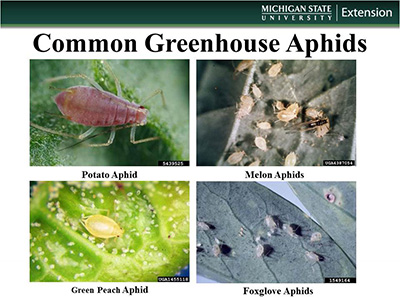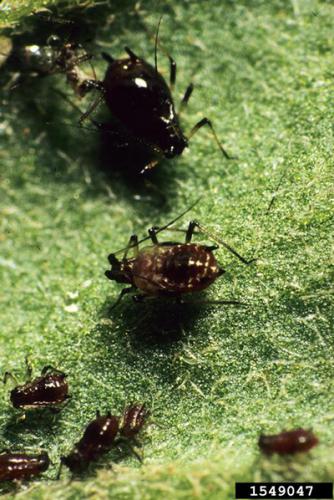What is that black aphid on my chrysanthemum?
Greenhouse growers should be scouting their mums for chrysanthemum aphids now.

The four most common types of aphids on greenhouse-grown horticultural crops are potato, melon, green peach and foxglove aphids. However, there are other aphid species that can infest your crops. Recently, there have been reports that growers have spotted black aphids on their chrysanthemum crops. These black aphids, Macrosiphoniella sanborni, are chrysanthemum aphids.
As their name implies, chrysanthemums are the only known hosts in North America. This species of aphid is darker than all of the most common aphids and the winged adults are 2 to 2.5 millimeters long. However, growers interested in identifying the aphid on their crop should not do so solely based on color, as the color of aphids can be affected by factors including symbiotic bacteria and their food source. Send a sample to Michigan State University Diagnostic Services for a positive identification.

The most common aphid species that are a pest of greenhouse crops are potato, melon, green peach and foxglove aphids. Photos: Bugwood.org.

Chrysanthemum aphid, Macrosiphoniella sanborni. Photo: Jim Baker, North Carolina State University, Bugwood.org.
Like other aphids, chrysanthemum aphids use their piercing and sucking mouthparts to suck out plant fluids, especially at the growing tips of plants. The aphids reproduce very rapidly; each female can reproduce four to eight offspring asexually per day. These aphids often colonize the stems near the growing tips.
As chrysanthemum aphids reproduce rapidly, MSU Extension suggests treating aphid colonies as soon as they are spotted. We recommend the following products for aphid control: Aria, azadarachtin, BotaniGard, Distance, Endeavor, Enstar II, Kontos, Ornazin or Orthene 97. The following neonicotinoids will be effective: imidacloprid, Safari, Flagship applied as a soil drench or as a spray and Tristar as a spray. For aphids that are highly resistent to insecticide applications, growers should try Aria, Endeavor or Orthene 97, as many aphids are resistent to the pyrethroid class of insecticides.
For more information on chrysanthemum aphids, check out “A Refresher on Aphids” by Steve Frank, North Carolina State University, and “Chrysanthemum Aphid” from the University of Florida Extension.
Note: Product names are given for information purposes only and are not an endorsement, nor is any criticism implied of products not mentioned.



 Print
Print Email
Email




